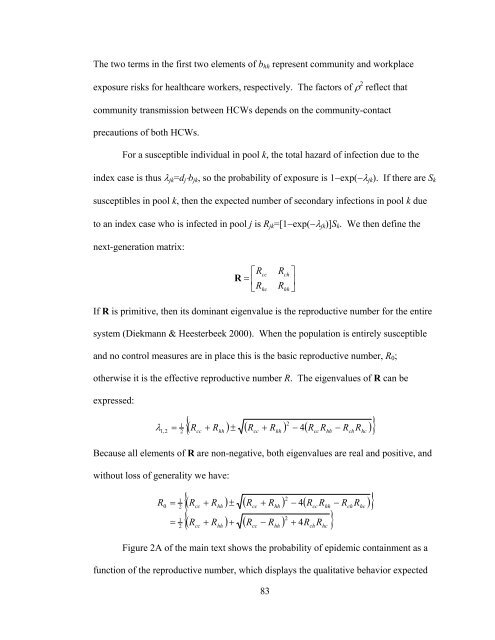K - College of Natural Resources - University of California, Berkeley
K - College of Natural Resources - University of California, Berkeley
K - College of Natural Resources - University of California, Berkeley
You also want an ePaper? Increase the reach of your titles
YUMPU automatically turns print PDFs into web optimized ePapers that Google loves.
The two terms in the first two elements <strong>of</strong> bhh represent community and workplace<br />
exposure risks for healthcare workers, respectively. The factors <strong>of</strong> ρ 2 reflect that<br />
community transmission between HCWs depends on the community-contact<br />
precautions <strong>of</strong> both HCWs.<br />
For a susceptible individual in pool k, the total hazard <strong>of</strong> infection due to the<br />
index case is thus λjk=dj⋅bjk, so the probability <strong>of</strong> exposure is 1−exp(−λjk). If there are Sk<br />
susceptibles in pool k, then the expected number <strong>of</strong> secondary infections in pool k due<br />
to an index case who is infected in pool j is Rjk=[1−exp(−λjk)]Sk. We then define the<br />
next-generation matrix:<br />
⎡R<br />
R = ⎢<br />
⎣R<br />
cc<br />
hc<br />
If R is primitive, then its dominant eigenvalue is the reproductive number for the entire<br />
system (Diekmann & Heesterbeek 2000). When the population is entirely susceptible<br />
and no control measures are in place this is the basic reproductive number, R0;<br />
otherwise it is the effective reproductive number R. The eigenvalues <strong>of</strong> R can be<br />
expressed:<br />
λ<br />
1,<br />
2<br />
R<br />
R<br />
2<br />
{ ( Rcc + Rhh<br />
) ± ( Rcc<br />
+ Rhh<br />
) − ( Rcc<br />
Rhh<br />
− RchR<br />
hc ) }<br />
ch<br />
hh<br />
⎤<br />
⎥<br />
⎦<br />
1 = 4<br />
2<br />
Because all elements <strong>of</strong> R are non-negative, both eigenvalues are real and positive, and<br />
without loss <strong>of</strong> generality we have:<br />
R<br />
0<br />
=<br />
=<br />
1<br />
2<br />
1<br />
2<br />
{ ( Rcc<br />
+ Rhh<br />
) ±<br />
2 ( Rcc<br />
+ Rhh<br />
) − 4(<br />
RccR<br />
hh − RchRhc<br />
) }<br />
( R + R ) + ( R − R<br />
2 ) + 4R<br />
R<br />
{ cc hh<br />
cc hh<br />
ch hc }<br />
Figure 2A <strong>of</strong> the main text shows the probability <strong>of</strong> epidemic containment as a<br />
function <strong>of</strong> the reproductive number, which displays the qualitative behavior expected<br />
83

















